Searching For The Remains of Manhattan’s Bloomingdale Insane Asylum
I was up scouting the Columbia University campus last week…
…and in the spirit of Halloween, I decided to swing by the building nestled just beside Low Library.
If you take a moment to stare at it, you’ll realize this little brick building doesn’t really match the surrounding Beaux Arts architecture.
In fact, the longer you look at it, the more you’ll realize just how out of place this three-story brick building looks compared to its surroundings.
This makes sense, of course, because the building dates to a time when Columbia University was located over 50 blocks south…
…and in its place was the Bloomingdale Insane Asylum:
Opened in 1821, the Bloomingdale Insane Asylum (or Bloomingdale Lunatic Asylum) was built on an enormous 38-acre parcel of farmland in what was then known as Bloomingdale, from the Dutch “bloomendaal,” or “vale of flowers.” The first mental hospital in the state, it offered patients a lush, manicured campus complete with gardens and paths, groves of trees, playgrounds and greenhouses, and views of the Hudson and Harlem River.
In fact, the original hospital building, made of brownstone and able to accommodate 200 patients…
…stood exactly where Columbia’s Low Library is today:
You can find the Asylum ominously identified on most 19th-century maps, stretching from 120th Street to about 112th Street or so.
In 1840, a new insane asylum for the indigent was opened on Roosevelt Island, and soon after, Bloomingdale began catering primarily to the wealthy and elite of society. The campus continued expanding through the decades, including the addition of wings to the original hospital building (compare the entrance below to the pictures above):
However, with city development rapidly moving north, the hospital’s governors knew their Manhattan oasis wasn’t long for this world. Land was purchased in White Plains for relocation, and the majority of the property was sold to Columbia University in 1892 for $2,000,000.
Today, just one building remains from the Bloomingdale Insane Asylum: Buell Hall, formerly known as the Macy Villa.
Here’s a picture from 1897 showing both the original asylum grounds and Columbia’s encroaching construction. You can see the Macy Villa on the far right:
The same view today:
Built in 1885, Macy Villa was the final building to be constructed at the Bloomingdale Insane Asylum. It was intended for the wealthiest male patients so that they could live in a residential setting, away from the noise and discomforts of the main hospital wards. It originally featured a wooden porch…
…but is otherwise virtually unchanged today:
The building was originally intended to be torn down once construction was completed but somehow managed to survive. It was moved back from 116th Street to its current position and has remained there ever since:
The Macy Villa is one of my absolute favorite buildings in New York. There is just something so surreal about touching its bricks and having that physical connection to a time when its surroundings would have been totally unrecognizable, a sprawling insane asylum located on a vast expanse of verdant land.
A time when the professors and students passing you by on the walks would have instead been doctors and nurses, patients and their families.
And here would have lived the wealthiest and most elite of those patients, those who found that their great success in life ultimately fell second to the power of their own minds.
The interior retains little of the original building, as it has been altered numerous times over the years to accommodate a myriad of Columbia groups and departments.
Finding information about the conditions at Bloomingdale is difficult. The hospital certainly offered the most advanced care of its day, but it’s frightening to think what that might have been. I came across one report of a doctor who had his wife committed to Bloomingdale after she complained about his frequenting brothels (she was only released after agreeing not to bring it up).
I don’t believe in ghosts, but if there’s one building at Columbia I’ve always thought should be haunted, it’s Buell.
There are a few other connections to the Bloomingdale Insane Asylum worth mentioning. Back in the day, one would take Asylum Lane off of Broadway (then known as Bloomingdale Road) to approach the hospital. As development spread north, the road was eventually lost under new construction (you can see it at the bottom of the map):
However, according to Andrew Dolkart in his book, Morningside Heights, remnants of Asylum Road can still be found in the strange angles of nearby buildings. Note the odd slants of the below properties…
…and you’ll see that a road could perfectly fit through. This would have been Asylum Road.
To anyone who’s ever eaten at the great Mexican restaurant The Heights, now you know why the interior has such a strange triangular shape:
A picture of the road leading up to the asylum:
Two other asylum buildings almost survived demolition. Located near 116th Street and Broadway was the Superintendent’s House:
Sadly, this was demolished in 1922 and replaced with Dodge Hall:
The other was a hospital building just west of Low Library, in use for only a short time before demolition.
Finally, probably the most mysterious remnant from the asylum is Columbia’s sprawling underground tunnel system connecting every building on campus, the oldest of which date back to the Bloomingdale days. They’re off-limits to students, and the old asylum tunnels in particular are reported to be very small, VERY hot, and extremely dangerous (of course, that doesn’t stop the tunnelers – check out this video for a quick trip into the bowels of Columbia).
It’s nothing short of a miracle that such a well-preserved building from the Bloomingdale Insane Asylum still exists. While visitors might overlook it for the more palatial Low Library, or the austere Butler Hall, I always take a moment to stare at Buell and try to think of it as it once was.
Then I get the strange feeling that someone’s watching me from one of those third floor windows and move on. Because you never know…
-SCOUT



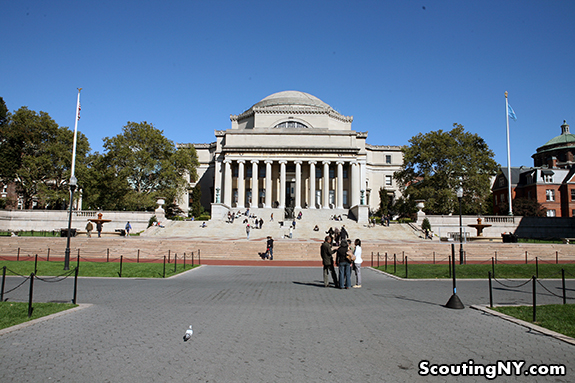
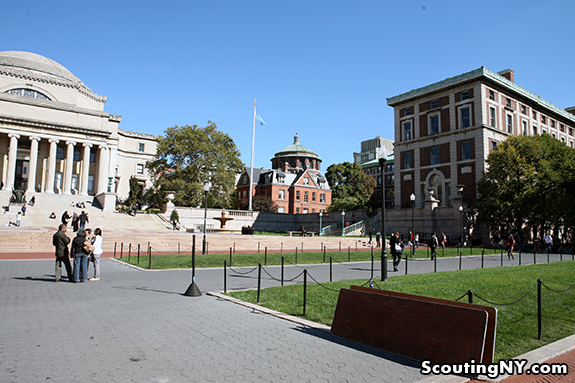
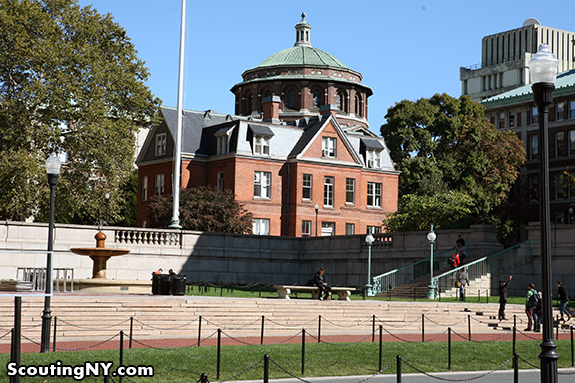


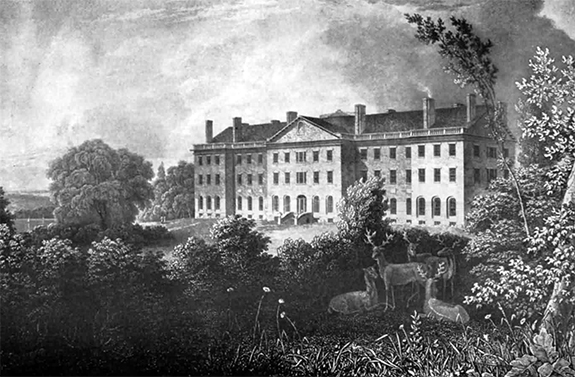

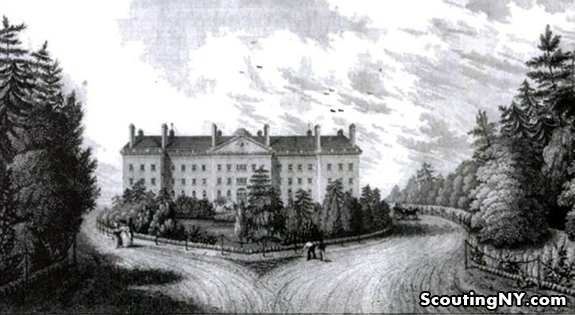
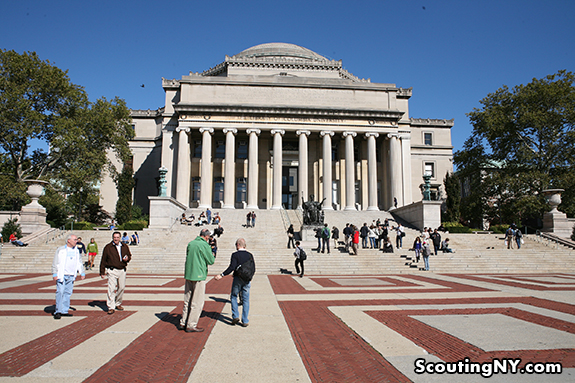
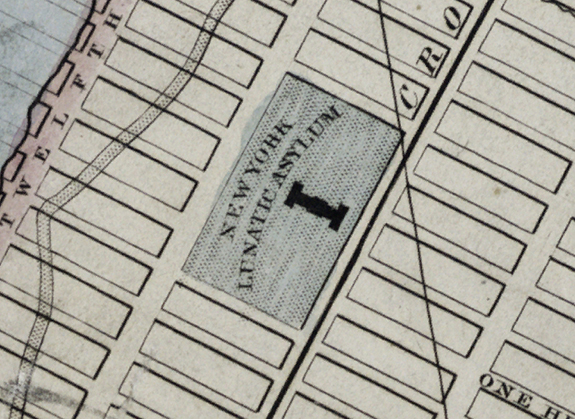



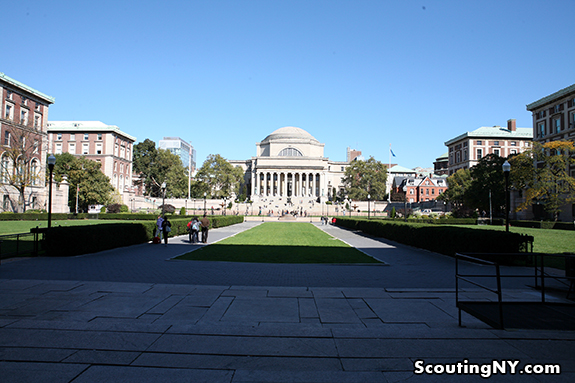




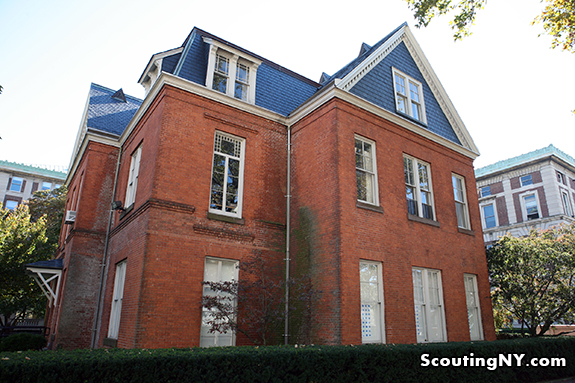


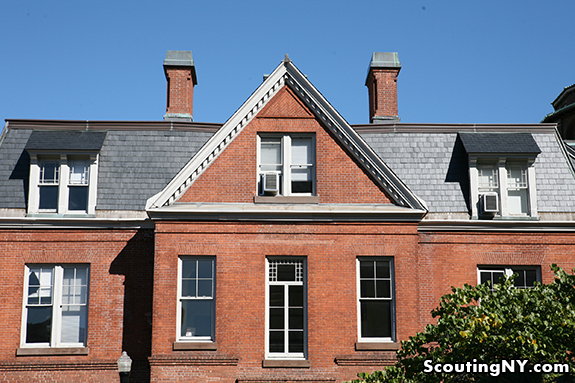
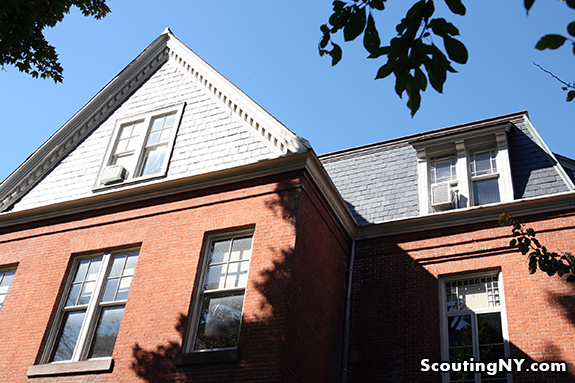
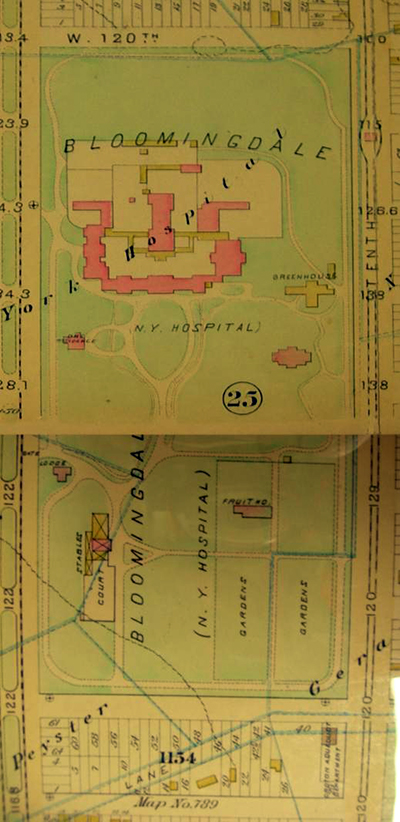
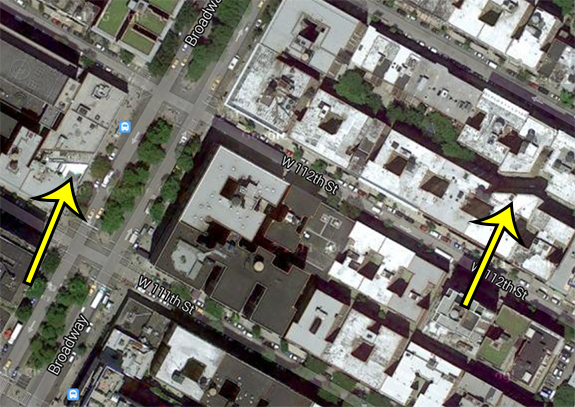


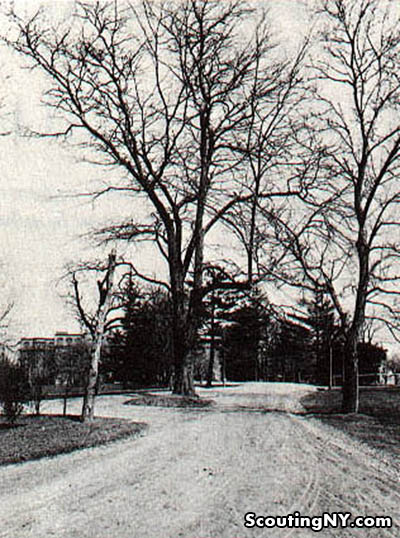

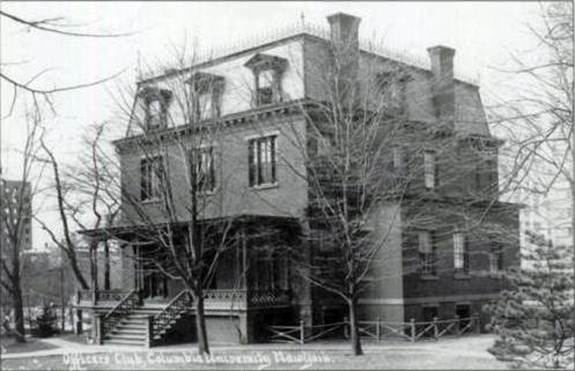

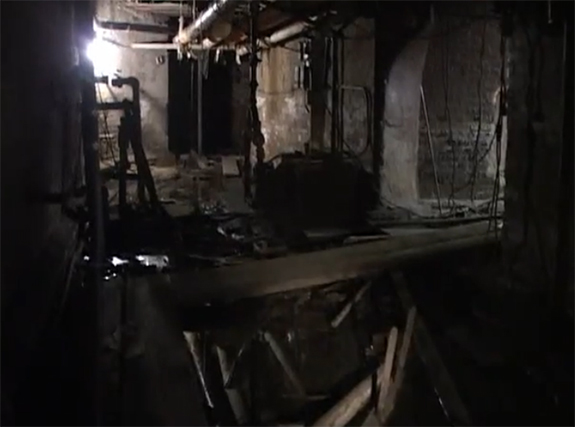
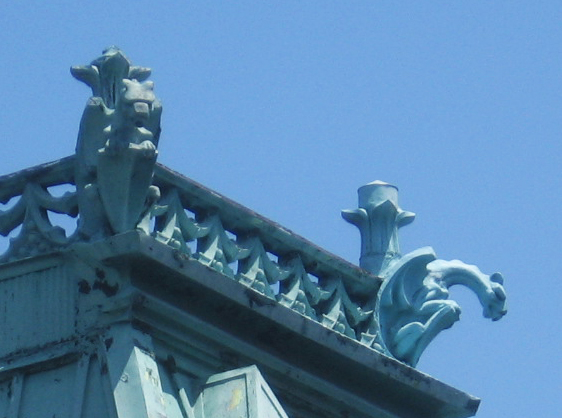

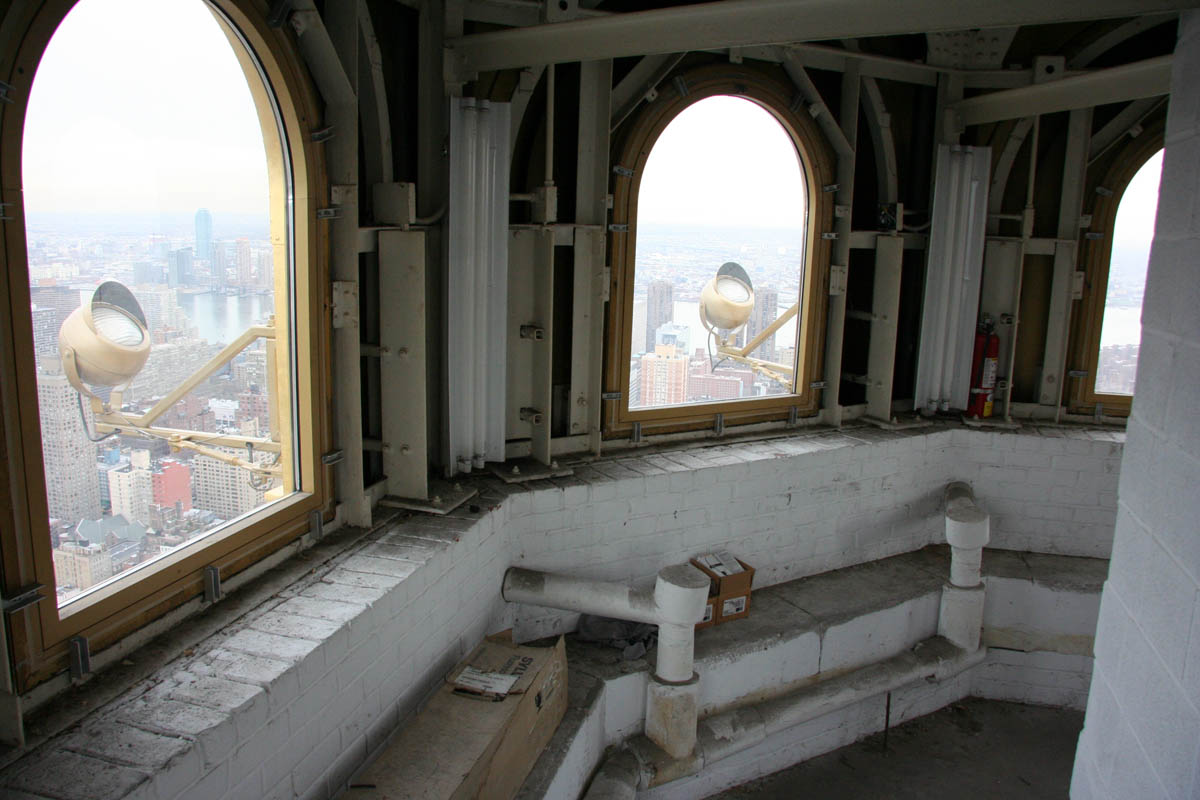



Another great story!! Scout, I love you!
You might be interested to go up to 21 Bloomingdale Road in White Plains to see where Columbia moved the Asylum. It was sold to NY Hospital and they not only duplicated Macy Villa but all the other buildings were strongly influenced by it. It is an interesting complex of buildings landscaped by Olmsted and under threat by developers. One of the last big open areas in White Plains.
Great post. You missed the best thing about Macy/Buell, though – this former lunatic asylum building is now home to… (drumroll) the architectural-history Ph.D. program! (Among other things.) You don’t have to be crazy to work in this field, but it sure doesn’t hurt.
Probably my favorite of your finds Scout! Love the tidbit about the angled buildings—history always leaves a mark in the present doesn’t it?
Back in the day, one would take Asylum Lane off of Broadway (then known as Bloomingdale Road) to approach the hospital.
One of Hartford’s major roads is to this day called Asylum Street/Avenue. It takes its name not from a mental hospital, but from a former name of what’s now the American School for the Deaf.
The more things change, the more they stay the same …
To this day, tell anybody who works in retail that you’re going to Bloomingdale’s and they’ll tell you you’re crazy.
Snooping into the past and piecing together long forgotten historical items. It must be fun figuring out puzzles like this.
Once again, your thoroughness and ability to capture interesting angles captured my interest. I know you are well equipped to film a movie, Scout, but you should also be a rich man by now based on your attention to detail and ability to research just about anything — from the obscure to the truly forgotten! Bravo, old boy. Bravo!
I am oddly enough researching New York Asylums in the 1900s for a show in production in New York. I would love to ask you where you have sourced your information. If you would please send me an email it would be greatly appreciated! Thank you for this awesome website!
Coco,
I’m not Scout, just a commenter who was inspired to find out more about Bloomingdale Asylum thanks to this wonderful post.
In the hope it’ll help, here are the best links for info:
1. A full-length book on-line called “A PSYCHIATRIC MILESTONE BLOOMINGDALE HOSPITAL CENTENARY 1821-1921”
http://www.gutenberg.org/files/15365/15365-h/15365-h.htm
2. Another full-length book (.pdf file) written in 1848 by Pliny Earle, M.D., a founding father of the predecessor of the American Psychiatric Association and superintendent of the hospital, called “A History, Description, and Statistics of the Bloomingdale Hospital for the Insane”
http://ia600303.us.archive.org/23/items/historydescripti00earlrich/historydescripti00earlrich.pdf
3. An unsourced anecdote about (and photo of) Jane Bielawski and her doll “Missy” which apparently appeared first on Pinterest.
“Following the suspicious deaths of some of her playmates in a NY tenement, police attempted to interview Jane. he young girl went crazy, accused her doll of the murders, & threw the doll out of her 5th floor apartment window while screaming, ‘Bad dolly! Naughty dolly!’ Jane was taken to Bloomingdale Asylum to be treated for hysteria. She never left the institution, dying an old woman in 1968. What happened to the doll remains a mystery.”
http://sherrylogsdon.com/jane-bielawski/
4. And, finally, a FASCINATING undercover investigation from 1872 by the New York Tribune for which reporter Julius Chambers feigned insanity in order to be admitted to the hospital and expose its conditions. (Some of the pages are .pdf files and some are .png images which are difficult to read but the series of reports and letters to the editor are AMAZING !)
http://dlib.nyu.edu/undercover/bloomingdale-asylum-expos%C3%A9-julius-chambers-new-york-tribune
Hope this helps and good luck with your project.
Luna C.
P.S.
In the hope that any appearance of obsessive fascination with the topic of insane asylums shall be off-set by its educational value, and with acknowledgement that my style of expression is perhaps too easily influenced by that of 19th century reportage, I humbly offer the following results of my humble endeavors to provide further information solely for your edification and amusement.
First, here’s an excerpt from the 1886 “Annual Report of the New York Hospital and Bloomingdale Asylum” to its Governors which describes the nearly-completed Macy Villa – a facility which, it seems worthy of re-iterating, was a facility constructed with donations from New York’s wealthiest class for the benefit of “lunatics” of equal stature, esteem and financial abundance:
“Mainly owing, directly and indirectly, to labor strikes, it has been found impossible, except at greatly increased cost, to advance the work on the Macy Villa as rapidly as was expected a year ago, but I am glad to be able to report that it has now been substantially completed. The furniture has been ordered and made, and the most of it is in the building, which will soon be ready for occupation. It is a very spacious and substantially built edifice; its interior finish and furniture are handsome and convenient. Very great pains have been taken to make its sanitary arrangements the most complete that are known to sanitary science and art, and it embraces very liberal provisions for the personal comfort and diversion of its occupants. Trusting and believing that it will be appreciated by the friends of gentlemen whose taste and means render the accomodations it affords necessary to their comfort and welface, and that it will long do honor both to the name and to the enlightened benevolence of your venerable President, it is now ready for the examination of the members of your honorable Board, and for your verdict as to its fitness to meet a want that has hitherto been less appreciated than the needs of the less favored of fortune.”
(The book from which that’s excerpted is a compilation of these Annual Reports submitted during the 1880s which contains a veritable mountain of fascinating information about Bloomingdale Asylum at that time. It can be found here: http://tinyurl.com/kmf966m )
In contrast, the accomodations afforded to “lunatics” of the lesser classes, as described by undercover reporter Julius Chambers in the New York Tribune some 14 years prior on Saturday, August 31, 1872 under the headline “Among the Lunatics,” were slightly less luxurious:
“No means was ever resorted to by those vested with the power of imprisonment which proved so effectual, in breaking the will, destroying hope, or inspiring madness, as confinement in a room the walls or ceiling of which are unbroken by any objects. The prison cells of revolutionary France, or Germany under feudal (looks like “suprerancy”?), could not have been better calculated for this effect than was the “den” to which the reporter was committed. Not a picture, nor even a nail from which at some past time one might have depended, adorned the walls. The door was devoid of a knob, and the reporter never fully realized before what an essential accompaniment the latter was to the former. The window was opposite the door and directly above the head of the bed, so that the night air blew in on the face of the sleeper. The floor had been recently scrubbed, and the patient discovered, when he removed his shoes, that it was still slightly damp. The odor of chloride of lime – which had been mingled with the water – was so strong in the cell as to make the quarters almost untenable, and to give the reporter a violent headache. The attendant, Townsend, stood by and listened with perfect indifference to the appeal for a room which did not smell so frightfully. As the patient undressed and laid aside one article of clothing after another, the attendant picked up each piece preparatory to carrying them outside the door and depositing them on the floor of the hall.”
http://dlib.nyu.edu/undercover/sites/dlib.nyu.edu.undercover/files/documents/uploads/editors/Among-the-Maniacs_NYSun_31Aug1872.pdf
I must now take hasty leave as the bell has just rung for basket-weaving class and, having wriggled out of my straight-jacket to post this missive, I must, with all alacrity, wriggle back into it.
Luna C.
(Shhhh ! This is merely a nom de plume — I am, in fact, Napolean Bonaparte, in hiding from my many enemies !)
The Jane Bielawski story is an urban legend or something of the sort. https://plus.google.com/u/0/112067062385768558463/posts/NNr6EFZQCuG?pid=6181835053466154770&oid=112067062385768558463
Fabulous post, Scout. You know how I love when you cover anything connected with Columbia. I knew all the info about Buell Hall (and love telling visitors about the building’s original use when I give tours of Butler Library and show them the view from the 6th-floor reading rooms: http://www.flickr.com/photos/19479358@N00/5860918017), but I didn’t know about Asylum Road, which pleases me enormously.
And the reason it pleases me so much is that my apartment looks out into that weird angled courtyard between Broadway and Amsterdam, and I’ve always wondered why that strange shape, that allows me to get so much light, existed in the first place.
First of all
Vampire in brooklyn has to be one of the worst Murphy’s movie
but i really wrote to ask you for a review of the Roseland Ballroom ccause’ i heard they r shutting down the place next April
nice blog man keep up!
Excellent story, and I love what you do, Scout. Splendid potential!
Hi,
The is a little typo in “bloomendaal”. It must be “bloemendaal”.
Bloemendaal is a Dutch place and got his name from the old word Blommendale. Probably it was a valley of flowers instead of a vale of flowers but as The Netherlands is pretty flat dont expect to much from a valley.
Keep up posting.
I’m doing family history, and just yesterday learned that one woman I am reseaching was in the old Bloomingdale Asylum. She was from a very wealthy family, and I am sure it was kept as secret as possible I haven’t found her death date yet but she was still in the asylum at 89. This was an interesting article especially with all the pictures.